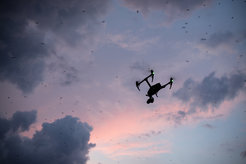Scientists are turning the powers of AI and Big Data towards preserving wildlife
Experts in artificial intelligence and animal ecology are pooling their efforts into a pioneering approach to conservation
A team of scientists from MPI-AB and other institutes have put forth a new, cross-disciplinary approach intended to enhance research on wildlife species and make more effective use of the vast amounts of data now being collected thanks to new technology. Their study appears today in Nature Communications.

Republished from EPFL
The field of animal ecology has entered the era of big data and the Internet of Things. Unprecedented amounts of data are now being collected on wildlife populations, thanks to sophisticated technology such as satellites, drones and terrestrial devices like automatic cameras and sensors placed on animals or in their surroundings. These data have become so easy to acquire and share that they have shortened distances and time requirements for researchers while minimizing the disrupting presence of humans in natural habitats. Today, a variety of AI programs are available to analyze large datasets, but they’re often general in nature and ill-suited to observing the exact behavior and appearance of wild animals. A team of scientists from EPFL and other universities has outlined a pioneering approach to resolve that problem and develop more accurate models by combining advances in computer vision with the expertise of ecologists. Their findings, which appear today in Nature Communications, open up new perspectives on the use of AI to help preserve wildlife species.
Building up cross-disciplinary know-how
Wildlife research has gone from local to global. Modern technology now offers revolutionary new ways to produce more accurate estimates of wildlife populations, better understand animal behavior, combat poaching and halt the decline in biodiversity. Ecologists can use AI, and more specifically computer vision, to extract key features from images, videos and other visual forms of data in order to quickly classify wildlife species, count individual animals, and glean certain information, using large datasets. The generic programs currently used to process such data often work like black boxes and don’t leverage the full scope of existing knowledge about the animal kingdom. What’s more, they’re hard to customize, sometimes suffer from poor quality control, and are potentially subject to ethical issues related to the use of sensitive data. They also contain several biases, especially regional ones; for example, if all the data used to train a given program were collected in Europe, the program might not be suitable for other world regions.
“We wanted to get more researchers interested in this topic and pool their efforts so as to move forward in this emerging field. AI can serve as a key catalyst in wildlife research and environmental protection more broadly,” says Prof. Devis Tuia, the head of EPFL’s Environmental Computational Science and Earth Observation Laboratory and the study’s lead author. If computer scientists want to reduce the margin of error of an AI program that’s been trained to recognize a given species, for example, they need to be able to draw on the knowledge of animal ecologists. These experts can specify which characteristics should be factored into the program, such as whether a species can survive at a given latitude, whether it’s crucial for the survival of another species (such as through a predator-prey relationship) or whether the species’ physiology changes over its lifetime. “For example, new machine learning algorithms can be used to automatically identify an animal such as using a zebra's unique stripe pattern, or in video their movement dynamics can be a signature of identity," says Prof. Mackenzie Mathis, the head of EPFL's Bertarelli Foundation Chair of Integrative Neuroscience and co-author of the study. "Here is where the merger of ecology and machine learning is key: the field biologist has immense domain knowledge about animal being studied, and us as machine learning researchers, our job is to work with them to build tools to find a solution."
Getting the word out about existing initiatives
The idea of forging stronger ties between computer vision and ecology came up as Tuia, Mathis and others discussed their research challenges at various conferences over the past two years. They saw that such collaboration could be extremely useful in preventing certain wildlife species from going extinct. A handful of initiatives have already been rolled out in this direction; some of them are listed in the Nature Communications article. For instance, Tuia and his team at EPFL have developed a program that can recognize animal species based on drone images. It was tested recently on a seal population. Meanwhile, Mathis and her colleagues have unveiled an open-source software package called DeepLabCut that allows scientists to estimate and track animal poses with remarkable accuracy. It’s already been downloaded 300,000 times. DeepLabCut was designed for lab animals but can be used for other species as well. Researchers at other universities have developed programs too, but it’s hard for them to share their discoveries since no real community has yet been formed in this area. Other scientists often don’t know these programs exist or which one would be best for their specific research.
That said, initial steps towards such a community have been taken through various online forums. The Nature Communications article aims for a broader audience, however, consisting of researchers from around the world. “A community is steadily taking shape,” says Tuia. “So far we’ve used word of mouth to build up an initial network. We first started two years ago with the people who are now the article’s other lead authors: Benjamin Kellenberger, also at EPFL; Sara Beery at Caltech in the US; and Blair Costelloe at the Max Planck Institute in Germany.”












